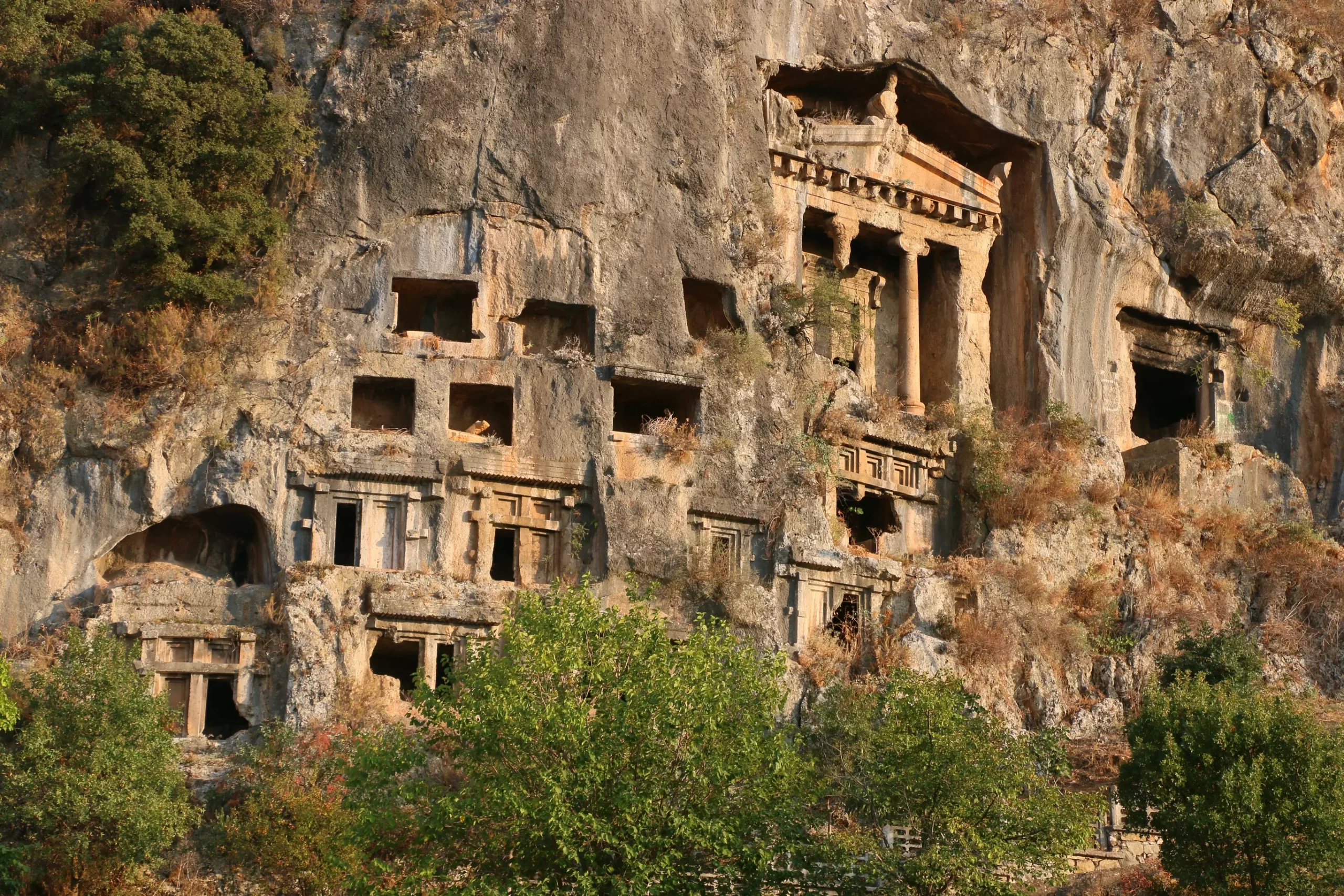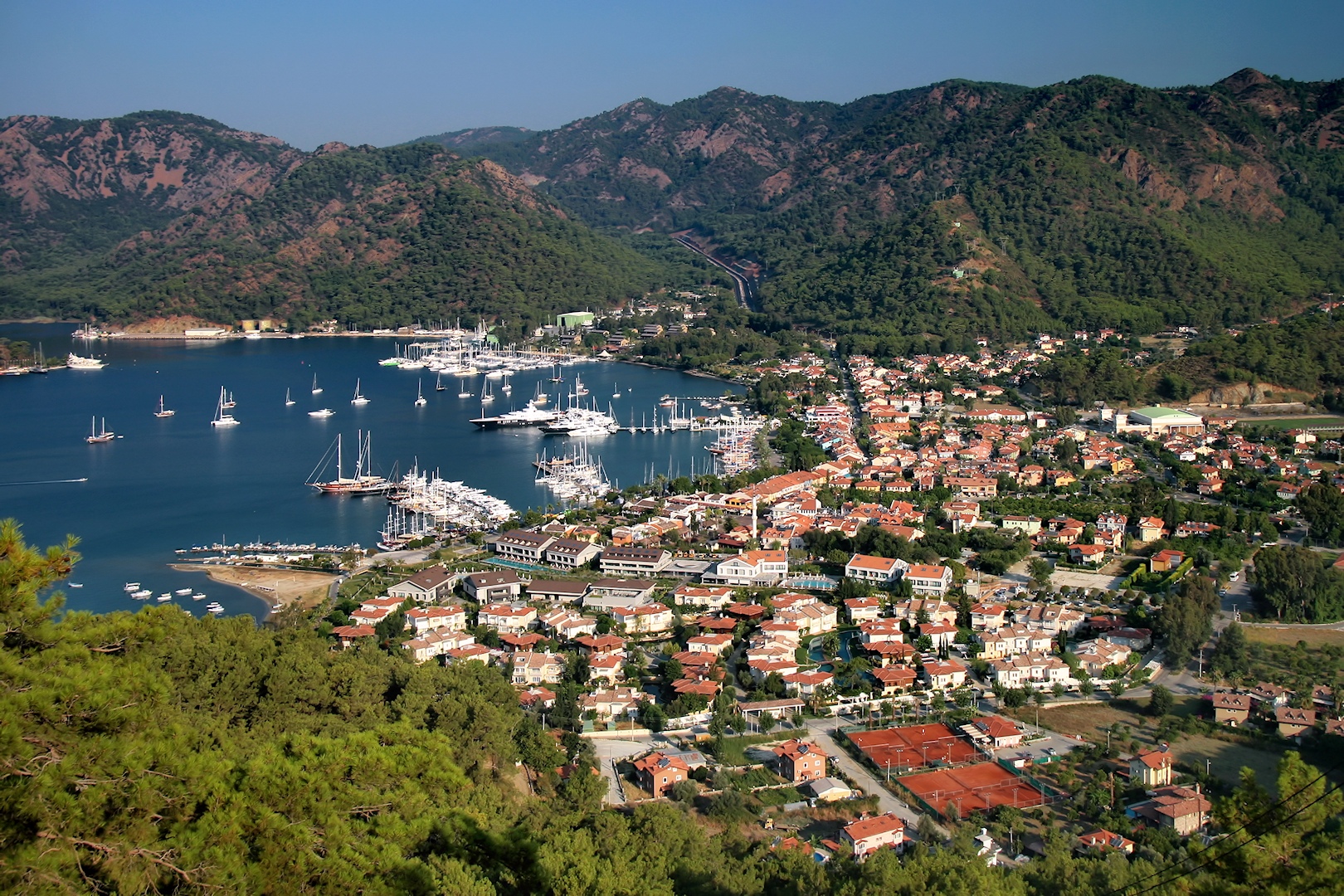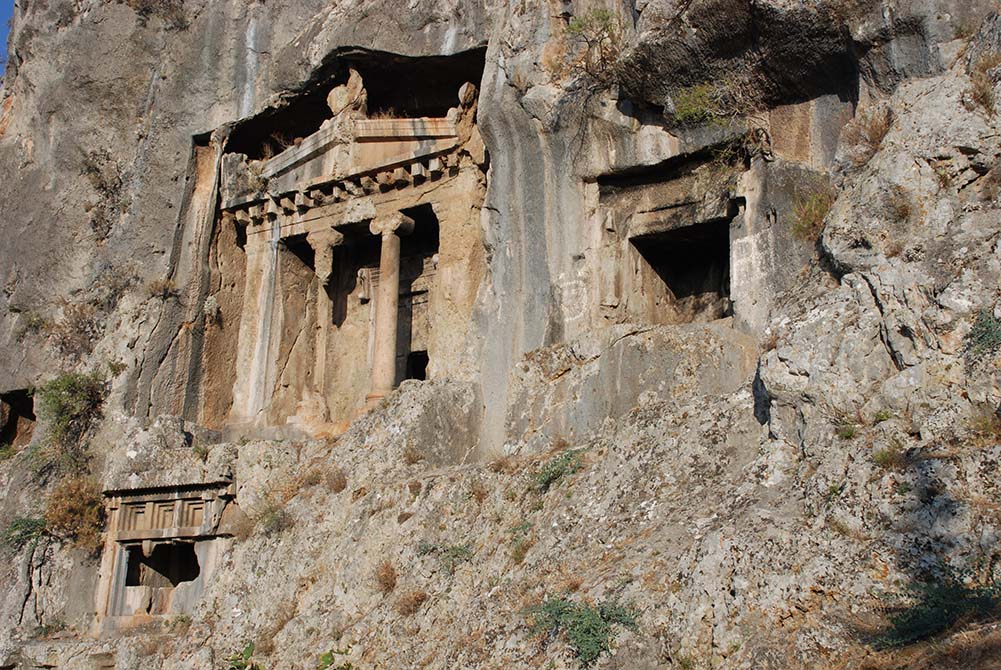As you wander through the vibrant streets of Fethiye, have you ever lifted your gaze to notice the magnificent monuments carved like lace into the steep cliffside? Have you ever wondered what secrets lie behind those colossal stone doors, standing like guardians of the city? For many of us, these rock tombs are a familiar part of the Fethiye skyline—monuments that inspire awe from a distance but keep their mysteries close. In this article, we invite you on an adventure that will take you not just to a viewing terrace, but into the heart of a millennia-old enigma. Here are the bestthings to do at the Fethiye Rock Tombs and what you'll experience as you ascend to this ancient wonder. This climb will not only offer you an unforgettable view but will also connect you with the soul of an ancient civilization.
Climb to the Tomb of Amyntas in the heart of the city
Your adventure begins in the heart of Fethiye, right in the midst of the flow of modern life. One of the most impressive aspects of the Rock Tombs is that you don't have to travel for miles out of the city to reach them. As you leave the city's energy behind and follow the signs, you'll be greeted by the famous steps that will transport you into the silence of history.
Don't be intimidated by the climb of nearly one hundred well-maintained steps. Think of these stairs as a time machine, carrying you not just meters upward, but centuries back. With every step you take, the sounds of the city below gradually fade, replaced by the whisper of the wind and the rhythm of your own breath. This physical effort becomes a ritual, preparing you mentally for what's to come; you feel yourself disconnecting from the modern world and approaching an ancient sanctuary. So, take your time with the ascent; there's no need to rush. Remember to bring a bottle of water, and especially in the summer, choose the cooler morning or late afternoon hours for your climb instead of the midday heat.

Watch the view of Fethiye Bay from the tomb's entrance
When you reach the top of the stairs, the reward waiting for you is simply breathtaking. The panoramic view of Fethiye Bay that suddenly unfolds before you is captivating enough to make you forget all your fatigue. It's a magical moment where time seems to stand still, and the past and present merge. The deep blue waters below, the gentle sway of boats in the marina, Knight Island visible in the distance, and the modern city of Fethiye at your feet... it's all as picturesque as a postcard.
What makes this view truly special is that it has remained almost unchanged for nearly 2,400 years. Cities may have been built and civilizations may have changed, but the unique geography of the bay, the silhouette of the mountains, and the color of the sea are just as the Lycians saw them. When the Lycians chose this spot for their ruler, Amyntas, they aimed not only to leave behind a majestic monument but also to gift him this unparalleled beauty to watch over for eternity. Therefore, as you stand at the entrance of the tomb and gaze at the view, you are actually sharing a perspective that spans millennia. This is more than just enjoying a scenic outlook; it's sharing a moment that transcends time. For photography enthusiasts, the "golden hours" near sunset are an unmissable opportunity. The warm colors created by the sun as it descends towards the sea make this historic landscape even more dramatic and unforgettable.

Feel the history of this monumental tomb from the Lycians
Once you pull yourself away from the mesmerizing view and turn around, you come face to face with the true host of this place: the Tomb of Amyntas. So, who were the Lycians who built these magnificent monuments? They were one of history's most enigmatic and freedom-loving civilizations. Living in the southwest of ancient Anatolia, the Lycians were known for their unique language, art, and democratic union.
One of the most distinctive features of Lycian culture is their burial traditions. They believed that the souls of the dead were carried to the afterlife by winged creatures, so they buried their dead as high as possible, closer to the sky and the gods. This is why they carved their most important tombs like eagles' nests into inaccessible, steep cliffs. This was not just a display of status, but a reflection of a deep-seated belief. The Tomb of Amyntas is one of the most splendid examples of this belief. Its facade, resembling an Ionic temple, emphasizes that this is a sacred space. On the left column of the tomb, there is a 2,400-year-old signature: "Amyntou tou Ermagiou," meaning "Amyntas, son of Hermagios". We know the name of the person who commissioned this monument, but his identity and story as a ruler have been lost to the mists of time. This makes the Tomb of Amyntas even more mysterious. We can only imagine the story of this powerful individual who left such a colossal work to be remembered forever. If you wish to trace the footsteps of the Lycians further, you can learn more about the historic (
https://www.yerelrehber.com/en/city/mugla/things-to-do) that starts in Fethiye and extends to Antalya.

Practical Information: What to Know When Planning Your Visit
To make your visit as enjoyable as possible, it's a good idea to note the following practical information:
| Feature | Details |
|---|---|
| Location | Fethiye, Kesikkapı Neighborhood (within walking distance of the city center)
|
| Entrance Fee | Approximately €3 (Please confirm the current fee before your visit)
|
| Museum Pass | Valid for entry
|
| Visiting Hours | Summer (April-October): ~08:30 - 19:30, Winter: ~08:30 - 17:30
|
| Transportation | Easily accessible on foot from Fethiye center or by local minibusses (dolmuş)
|
| Tip | For the best views and photos, prefer visiting near sunset
|
Conclusion: While You're Here...
Climbing to the Fethiye Rock Tombs is more than just visiting a historical site; it's an experience where history, adventure, and nature intertwine, touching your soul. However, your exploration of Fethiye doesn't have to end after you descend from this ancient hill.
Since you're already here, you might as well visit Fethiye Castle, just a 10-minute walk from the tombs. Although not much remains of the castle, the different perspective it offers of the Fethiye view is worth seeing, and entry is free. At the foot of the cliffs, the recently unearthed
Telmessos Ancient Theatre reveals the city's Roman-era layer. If you want to leave the ancient world behind and experience Fethiye's authentic spirit, head to the
Paspatur Bazaar (Old Town), famous for its narrow streets, souvenir shops, and charming cafes. To combine your visit to the Rock Tombs with other attractions in Fethiye, be sure to check out our comprehensive (
https://www.yerelrehber.com/en/city/mugla) guide.
Frequently Asked Questions (FAQ)
1. Is the climb to the Fethiye Rock Tombs difficult? Is it suitable for children? Answer: The climb consists of about 100 steps and is manageable for anyone with average fitness. It might be tiring for very young children or those with mobility issues. It's best to take it at a slow pace with breaks.
2. Can you go inside the Tomb of Amyntas? Answer: Yes, you can climb up to the entrance of the main tomb, Amyntas, and see the carved burial chamber. However, the chamber itself is empty today. The other smaller tombs are not accessible for climbing.
3. What is the best time to visit? Answer: The ideal times to see the view at its best and take stunning photos are early in the morning or during the "golden hours" just before sunset. These times are especially recommended in the summer to avoid the oppressive midday heat.
Bibliography
For more detailed academic information about the Lycian period and rock tombs, as well as current visitor information, you can consult the official resources of the Republic of Türkiye Ministry of Culture and Tourism.
Source: Republic of Türkiye Ministry of Culture and Tourism - Muğla Amintas Archaeological Site.


 English
English Türkçe
Türkçe

@nurgulkarademir
Muhteşem bir ortam..görulmesi gereken ören yerlerinden
@remzioner
Buram buram tarih kusur aramadan seyredin bence keyfini çıkarın
@musaakdam
Kaç yüz bin yıllık tarihe tugce yazmışlar yazık
@sinancihanaksoy
Binlerce yıllık tarih kokan hoş bir yer.
@alpersahin4036
Şehir merkezinde Likya döneminden (MÖ 4yy) kalma, kayalara oyulmuş kaya mezarıdır. Yüze yakın düzgün basamakla Amintas’a çıkılır. Buradan Fethiye ve deniz manzarası harikadır.Statüsü yüksek kişiler için yapılmış, oyulmaya ve işlenmeye uygun kayalarda oluşturulmuş mezarlar. Şehir içinde Likya döneminden kalma M.Ö. 4.yy. eserleri dikkati çeker. Bunlar, şehrin simgesi haline gelen doğal kayaya oyulmuş mezarlardır. Çok sayıda düzgün basamaklarla mezarların en güzel ve en görkemlisi olan Amintas'a ulaşılır. Bu mezar aşağıdaki düzlükten de kolaylıkla görülür ve yaklaştıkça, büyüklüğü karşısında duyulan hayranlık artar. Soldaki sütunun orta kısmında, M.Ö. 4. yy. alfabesi ile ''herpamiasoğlu amintas'' yazılıdır. Bu kişinin kimliği tam olarak bilinmemektedir.İlçede görülmeye değer pek çok lahit mezar bulunmaktadır. Bunlardan en önemlisi Likya dönemine ait olanıdır. İki katlı ön yüzünde dörtgen, ahşap kirişleri andıran oymalar ve gotik stili kemerli bir kapağı bulunmaktadır. Kapağın her iki yanı savaşları resmeden fresklerle bezenmiş olup, bunların kişinin yaşamı ile ilgili olduğu sanılmaktadır.
@yasincetin7308
Çok vaktimiz yoktu, yukarı çıkmadan aşağıdan biraz izledik. "Şehir merkezinde Likya döneminden (MÖ 4yy) kalma, kayalara oyulmuş kaya mezarıdır. Yüze yakın düzgün basamakla Amintas’a çıkılır. Buradan Fethiye ve deniz manzarası harikadır.Statüsü yüksek kişiler için yapılmış, oyulmaya ve işlenmeye uygun kayalarda oluşturulmuş mezarlar. Şehir içinde Likya döneminden kalma M.Ö. 4.yy. eserleri dikkati çeker. Bunlar, şehrin simgesi haline gelen doğal kayaya oyulmuş mezarlardır. Çok sayıda düzgün basamaklarla mezarların en güzel ve en görkemlisi olan Amintas'a ulaşılır. Bu mezar aşağıdaki düzlükten de kolaylıkla görülür ve yaklaştıkça, büyüklüğü karşısında duyulan hayranlık artar. Soldaki sütunun orta kısmında, M.Ö. 4. yy. alfabesi ile ''herpamiasoğlu amintas'' yazılıdır. Bu kişinin kimliği tam olarak bilinmemektedir.İlçede görülmeye değer pek çok lahit mezar bulunmaktadır. Bunlardan en önemlisi Likya dönemine ait olanıdır. İki katlı ön yüzünde dörtgen, ahşap kirişleri andıran oymalar ve gotik stili kemerli bir kapağı bulunmaktadır. Kapağın her iki yanı savaşları resmeden fresklerle bezenmiş olup, bunların kişinin yaşamı ile ilgili olduğu sanılmaktadır."
@kysspectra4508
Giriş ücreti nakit 15 TL veya Müzekart ile. Bir tane kaya mezara merdivenle çıkış var yandaki iki taneye de bağlantı yapılsa çok iyi olurdu. Tarihi yerleri seven biri olarak gidilir görülür. İnsanlar her zamanki gibi duvarlara isim yazıp zarar vermiş, yerlere çöplerini atmış, biraz bakımsız kalmış fakat manzarası efsane.
@tunahand92
Şehir merkezinde Likya döneminden (MÖ 4yy) kalma, kayalara oyulmuş kaya mezarıdır. Yüze yakın düzgün basamakla Amintas’a çıkılır. Buradan Fethiye ve deniz manzarası harikadır. Statüsü yüksek kişiler için yapılmış, oyulmaya ve işlenmeye uygun kayalarda oluşturulmuş mezarlar. Şehir içinde Likya döneminden kalma M.Ö. 4.yy. eserleri dikkati çeker. Bunlar, şehrin simgesi haline gelen doğal kayaya oyulmuş mezarlardır. Çok sayıda düzgün basamaklarla mezarların en güzel ve en görkemlisi olan Amintas'a ulaşılır. Bu mezar aşağıdaki düzlükten de kolaylıkla görülür ve yaklaştıkça, büyüklüğü karşısında duyulan hayranlık artar. Soldaki sütunun orta kısmında, M.Ö. 4. yy. alfabesi ile ''herpamiasoğlu amintas'' yazılıdır. Bu kişinin kimliği tam olarak bilinmemektedir. İlçede görülmeye değer pek çok lahit mezar bulunmaktadır. Bunlardan en önemlisi Likya dönemine ait olanıdır. İki katlı ön yüzünde dörtgen, ahşap kirişleri andıran oymalar ve gotik stili kemerli bir kapağı bulunmaktadır. Kapağın her iki yanı savaşları resmeden fresklerle bezenmiş olup, bunların kişinin yaşamı ile ilgili olduğu sanılmaktadır. Şehri tepeden gören bu kaya mezarları, gerçekten krallara layık bir konuma yerleştirilmiş :)
@nidacivelek
Kayalar içerisine oyulmuş gerçek bir sanat eseri olan mezarlıklar. Mezarlıklara geldiğinizde yokuş başındaki mezarlıkları ücretsiz gezebilirsiniz ancak merdiven olmadığı için tırmanırken dikkat etmek lazım. 100 m yukarıda ise ücretli olarak girilen bu alanda çok iyi korunmuş bir anıt mezar var. Ciddi sayıda merdivenden tırmanarak ulaşılıyor ancak tırmanıp burada hem mezarı hem de şehir manzarasını seyretmeye değer.
@mustafasaidceyl
Şehir merkezinde Likya döneminden (MÖ 4yy) kalma, kayalara oyulmuş kaya mezarıdır. Yüze yakın düzgün basamakla Amintas’a çıkılır. Buradan Fethiye ve deniz manzarası harikadır.Statüsü yüksek kişiler için yapılmış, oyulmaya ve işlenmeye uygun kayalarda oluşturulmuş mezarlar. Şehir içinde Likya döneminden kalma M.Ö. 4.yy. eserleri dikkati çeker. Bunlar, şehrin simgesi haline gelen doğal kayaya oyulmuş mezarlardır. Çok sayıda düzgün basamaklarla mezarların en güzel ve en görkemlisi olan Amintas'a ulaşılır. Bu mezar aşağıdaki düzlükten de kolaylıkla görülür ve yaklaştıkça, büyüklüğü karşısında duyulan hayranlık artar. Soldaki sütunun orta kısmında, M.Ö. 4. yy. alfabesi ile ''herpamiasoğlu amintas'' yazılıdır. Bu kişinin kimliği tam olarak bilinmemektedir.İlçede görülmeye değer pek çok lahit mezar bulunmaktadır. Bunlardan en önemlisi Likya dönemine ait olanıdır. İki katlı ön yüzünde dörtgen, ahşap kirişleri andıran oymalar ve gotik stili kemerli bir kapağı bulunmaktadır. Kapağın her iki yanı savaşları resmeden fresklerle bezenmiş olup, bunların kişinin yaşamı ile ilgili olduğu sanılmaktadır. Giriş ücreti 20TL ve müzekart geçerli.